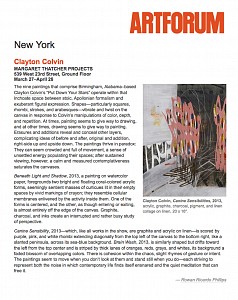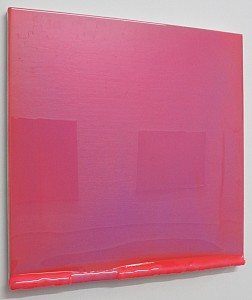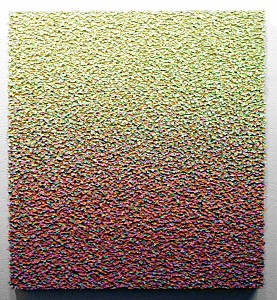Structure and Imagery: Clayton Colvin and Tegene Kunbi @ Margaret Thatcher Projects
April 20, 2014 - Paul Behnke

April 20, 2014 - Paul Behnke

April 19, 2014 - Rowan Ricardo Phillips
The nine paintings that comprise Birmingham, Alabama–based Clayton Colvin’s “Put Down Your Stars” operate within that inchoate space between stoic, Apollonian formalism and exuberant figural expression. Shapes—particularly squares, rhombi, strokes, and arabesques—vibrate and twist on the canvas in response to Colvin’s manipulations of color, depth, and repetition. At times, painting seems to give way to drawing, and at other times, drawing seems to give way to painting. Erasures and additions reveal and conceal other layers, complicating ideas of before and after, original and addition, right-side up and upside down. The paintings thrive in paradox: They can seem crowded and full of movement, a sense of unsettled energy populating their spaces; after sustained viewing, however, a calm and measured contemplativeness saturates the canvases.
Read More >> Download Article (PDF)March 31, 2014 - Oscar Laluyan
The dreary and gray winter mitigates a splash of color to rouse up our dull stupor from this never ending cold spell. Thank God for Margaret Thatcher Projects in presenting dual shows where their artists are bold significant users of color meant to chase away the winter blues.
Last March 27th, AF came to the opening of Clayton Colvin: Put Down Your Stars and Tegene Kunbi: Melting Pot. Softness in the application of color on linen was key in the work of Colvin where a sense of space seemed to take one into another plane that makes it a transcendental experience. Kunbi with his blocks of mid-range tone color defined spaces and sections where one explored places within the quadrant. Both were a visual treat to the senses and a real color laden palette that punctuates a breath of verve to decrease the desolate feeling of that last grasp of winter.
March 20, 2014 - Brian Edmonds
I recently visited the studio of Clayton Colvin in Birmingham, Alabama. The conversation below took place during the visit and through an exchange of emails over a period of time.
Brian Edmonds: Clayton, could you explain your studio routine? I know you recently moved into a new studio space. Has this affected your work, if so then how?
Clayton Colvin: I work in a studio at my home, which makes it possible for me to work when time presents itself. I try to work 4-5 hours, 5 days a week, but it is not so predictable.
|
|
March 1, 2014 - Cassie Cummins
Upon first glance, “Color Virus,” the third solo exhibition of Belgian artist Jus Juchtmans currently up at Margaret Thatcher Projects, seems to speak to or qualify itself within the monochrome painting movement. Each of Juchtmans’ pieces is a kind of meditation on a color: one blue, another red, another yellow, another white. As such, the show seems to beg the question of what significance can be found in a monochrome painting made today, many decades after the heyday of monochrome painters like Yves Klein or Kazimir Malevich.
Download Article (PDF)
February 6, 2014 - Shona Macdonald
Pouring it On gives us the opportunity to examine how both of these statements from over sixty years ago can, in the context of contemporary painting, coexist rather than contradict one another...Cathy Choi pours layers of acrylic and resin on her canvas, creating a luminous surface of fluidity and movement. The qauntity and excess of material discharged onto the canvas are restrained in a kind of untertow. She engages in a conversation with the material, more or less as an equal partner. The resin and acrylic flow inevitably to the bottom, gravity asserts itself, and the point of termination bends light—perfectly. The total effect is that, within the limitless reservoir of color and light, we have serenity in abundance.
Download PDF to read the full essay.
Download Article (PDF)
February 6, 2014 - Jeannette Cole
Pouring it On gives us the opportunity to examine how both of these statements from over sixty years ago can, in the context of contemporary painting, coexist rather than contradict one another...Informed by his degrees in Painting, Art History, and Religious Studies, Robert Sagerman discovers the meditative dimensions of emplacing paint on a surface. The strict structure allows profuse paint application and maximum saturation of color. This explosion in front of the surface is excessive, or would be, were it not for his process. Individual color blobs, squeezed onto the surface and terminating in pointy extensions, are almost fluorescent. His work focuses on the materiality of paint with the effect of transcending it and transforming it into a metaphysical event.
Download PDF to read the full essay.
Download Article (PDF)February 1, 2014 - Audrey Tran
Cathy Choi is a sculptural painter based in Bushwick and she recently participated in BOS ’11. For this post, I’ve posed a few questions about Choi’s practice and views of our community in contrast to the other art communities she’s experienced abroad.
Download Article (PDF)February 1, 2014 - Trenton Millar
This collection of William Betts artwork shows off the artist’s ability to create extremely realistic paintings using the pointillism style of painting. Rather than using just any photo as his reference to create his works, Betts uses security camera footage instead.
The pieces give the viewer the feeling that they are spying on someone. The pointillism technique adds to the grainy security cam theme that the paintings portray. The ideas of security and privacy make these paintings particularly relevant in the post-modern period.
Download Article (PDF)